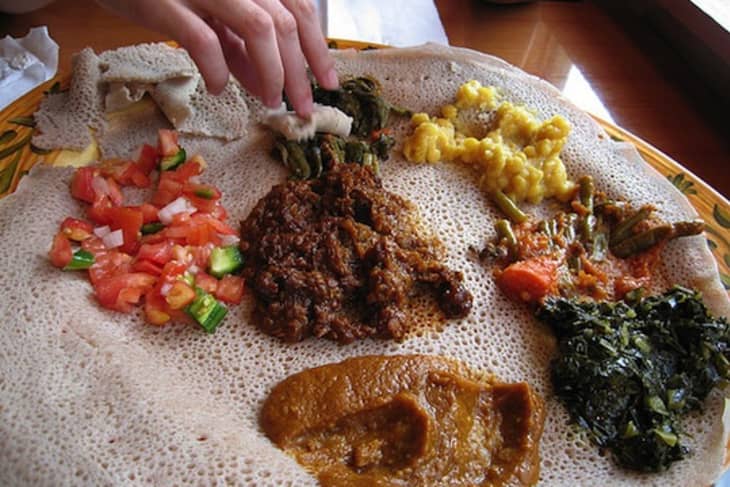Injera: Ethiopia’s Traditional Bread in Pictures and Words
If pictures aren’t enough to get me excited about trying a new food, then a good story certainly is. That’s the situation right now with injera, a crepe-thin bread that is a staple in Ethiopian cuisine. The book Cutting for Stone describes it like this: “The mark of a native is that your fingers are never stained by the curry; you use the injera as your tongs, as a barrier, while you pick up a piece of chicken or beef sopped in the sauce.” Mmmm. You had me at curry and now I need to know more.
Turns out there’s nothing quite like injera. Sour and spongy from the typical 5-day fermentation process, it also carries a distinct taste from Ethiopia’s native teff flour (which is actually gluten-free, too). The batter is poured right on top of a large black clay plate heated underneath by a wood burning oven. This passage from the book describes the traditional three-stone oven and cooking process.
A woman sold bundles of eucalyptus leaves used as cooking fuel for making injera – the pancake like food made from a grain, teff. [She would] pour batter on a huge flat griddle which sat on three bricks with a fire underneath. When the injera was ready, it would be peeled off like a tablecloth, then folded once, twice, and once more, and stored in a basket.
The large clay plate creates a large disc of injera, which curiously enough is often used as an edible tablecloth for dining. Sauces, wats (Ethiopian stews), and gored-gored (seasoned raw meat) are set right on top and sections of the injera are torn off to scoop up and eat the array of prepared proteins and lentils.
The sourness of the bread pairs well with the spiciness of the African spices (such as Berbere). Both flavors working to harmonize each other. Honey-wine and beer are enjoyed as the injera tablecloth shrinks and is eventually entirely consumed – signifying the end of the meal.
Celebrate African cuisine this week by preparing some of your own injera or by visiting an Ethiopian restaurant in your area to enjoy this deeply-rooted cultural tradition.
More on Injera:
•
10 African-Inspired Recipes
•
• All about Gluten-Free Teff
(Images: 1. Flickr user LollyKnit 2. Wikimedia Commons 3. Woman’s Day )
